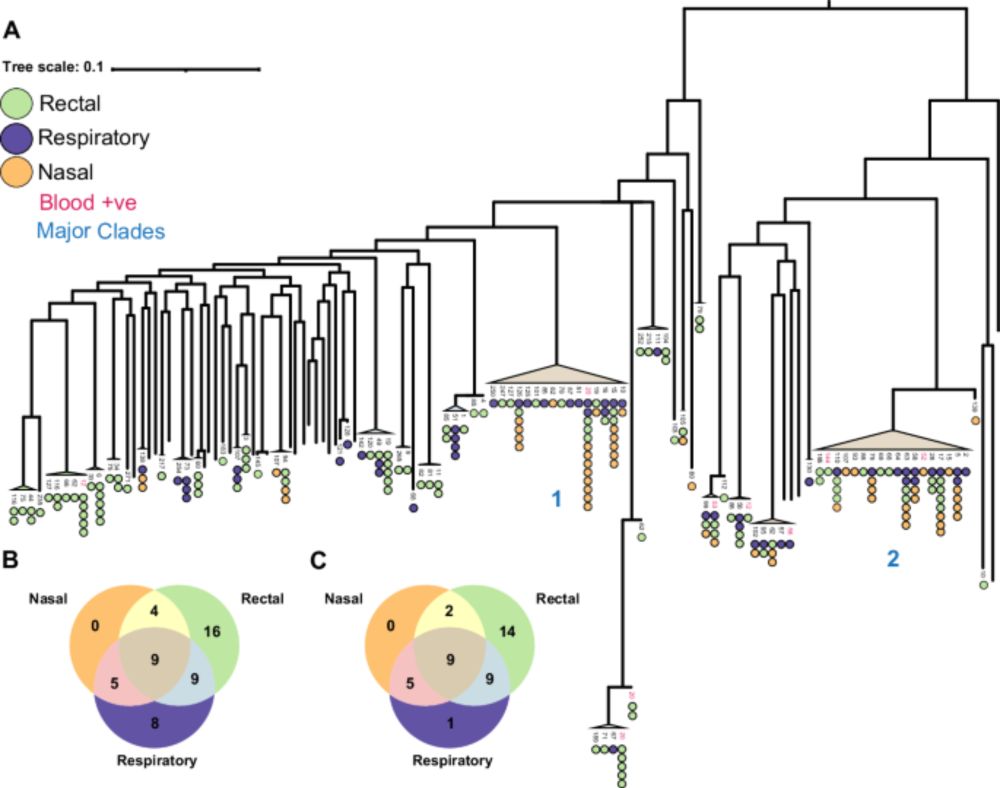
🎓: https://scholar.google.com/citations?hl=en&user=OBPpZq4AAAAJ&view_op=list_works&sortby=pubdate
👨💻: https://github.com/raufs
At 63C, most eukaryotic cells would be busy exploding noisily, forget even trying to divide.
The microbial universe never ceases to astound 😍
Thanks for letting us be a tiny part of this! #ExpandThemAll

At 63C, most eukaryotic cells would be busy exploding noisily, forget even trying to divide.
The microbial universe never ceases to astound 😍
Thanks for letting us be a tiny part of this! #ExpandThemAll
We found that hospital patients were frequently colonised with P. aeruginosa and that the same clone was shared between the gut and the lung.
The phylogenies indicate that the clones moved from lung->gut
www.nature.com/articles/s41...

We found that hospital patients were frequently colonised with P. aeruginosa and that the same clone was shared between the gut and the lung.
The phylogenies indicate that the clones moved from lung->gut
www.nature.com/articles/s41...
Work lead by the amazing Kevser Bilici!

Work lead by the amazing Kevser Bilici!
Here, with @asimovpress.bsky.social, I write about inconsistencies in the canonical story, and explore a few alternative theories about what really happened in that St. Mary's lab in the summer of 1928.

Here, with @asimovpress.bsky.social, I write about inconsistencies in the canonical story, and explore a few alternative theories about what really happened in that St. Mary's lab in the summer of 1928.
arxiv.org/abs/1808.07717

arxiv.org/abs/1808.07717

Editorial in @femsjournals.bsky.social microLife by @paulbrainey.bsky.social and colleagues
academic.oup.com/microlife/ad...

Editorial in @femsjournals.bsky.social microLife by @paulbrainey.bsky.social and colleagues
academic.oup.com/microlife/ad...

Specific host - #algae relationship, yet flexible bacterial #microbiome, in diatom-bearing foraminifera: Elsa Girard et al. www.science.org/doi/10.1126/...
#Protists #Microbes #Diatoms

Specific host - #algae relationship, yet flexible bacterial #microbiome, in diatom-bearing foraminifera: Elsa Girard et al. www.science.org/doi/10.1126/...
#Protists #Microbes #Diatoms
www.sciencedirect.com/science/arti...

www.sciencedirect.com/science/arti...

"DupyliCate - mining, classifying, and characterizing gene duplications"
doi.org/10.1101/2025...
#Bioinformatics #Python #Genomics #Evolution
@puckerlab.bsky.social

"DupyliCate - mining, classifying, and characterizing gene duplications"
doi.org/10.1101/2025...
#Bioinformatics #Python #Genomics #Evolution
@puckerlab.bsky.social
doi.org/10.1093/bioa...
The GlobDB is the largest species dereplicated genome database currently available, containing 306,260 species representatives.
More information on globdb.org 1/5
🖥️🧬🦠

doi.org/10.1093/bioa...
The GlobDB is the largest species dereplicated genome database currently available, containing 306,260 species representatives.
More information on globdb.org 1/5
🖥️🧬🦠

www.nature.com/articles/s41...

www.nature.com/articles/s41...
I am very excited to finally share what has been the main focus of my PhD for the past almost 3 years! It is about viral dark matter and a powerful tool we built to shed light on it. 🧬💡
Continue reading (🧵)

I am very excited to finally share what has been the main focus of my PhD for the past almost 3 years! It is about viral dark matter and a powerful tool we built to shed light on it. 🧬💡
Continue reading (🧵)

www.science.org/doi/10.1126/...

www.science.org/doi/10.1126/...
Congratulations to all the authors of the paper 🍾!
kwnsfk27.r.eu-west-1.awstrack.me/L0/https:%2F...
Cryo-EM reveals open and closed Asgard chromatin assemblies: Molecular Cell www.cell.com/molecular-ce...

Congratulations to all the authors of the paper 🍾!
kwnsfk27.r.eu-west-1.awstrack.me/L0/https:%2F...
Cryo-EM reveals open and closed Asgard chromatin assemblies: Molecular Cell www.cell.com/molecular-ce...


tomtom-lite is a re-implementation of tomtom targeting the ML age of genomics. Fast annotations ("what is this motif?") and simple large-scale discovery of motifs.
Check it out!
academic.oup.com/bioinformati...
tomtom-lite is a re-implementation of tomtom targeting the ML age of genomics. Fast annotations ("what is this motif?") and simple large-scale discovery of motifs.
Check it out!
academic.oup.com/bioinformati...

journals.plos.org/plosbiology/...

journals.plos.org/plosbiology/...

